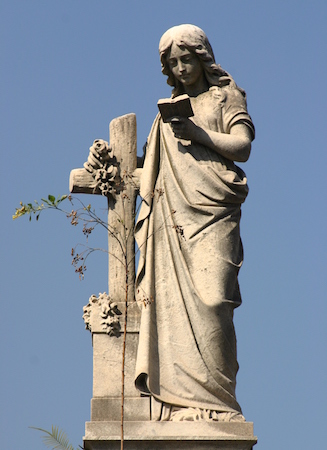
Documenting Recoleta Cemetery in Buenos Aires since 2007
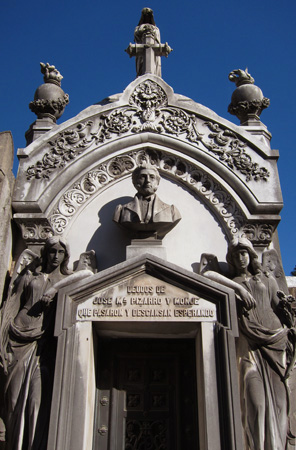
President Bernardino Rivadavia formed the Sociedad de Beneficencia in 1823 to perform charity work that had previously been the sole responsibility of the Catholic church. In spite of a rough start, by the beginning of the 20th century the organization became synonymous with the grand dames of Buenos Aires high society. It gave food & shelter to orphans, provided a role model for wayward kids, ran hospitals, & taught boys & girls “gender-based” work skills. Was this child labor? Sure. Did the elite maintain power & influence through this organization? Definitely. As a highly-visible symbol of upper class control, Perón replaced their work with the Fundación Eva Perón… & the rest is history.
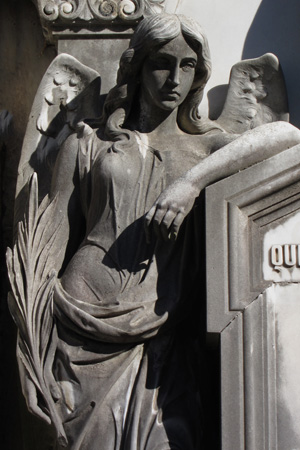
José María Pizarro y Monje had substantial real estate holdings dating from the early 1800s. As part of the landed Argentine elite, his only daughter —Cornelia Pizarro— worked endlessly with the Sociedad de Beneficencia. She developed a friendship with President Bartolomé Mitre & became known for organizing raffles to raise funds for charity.
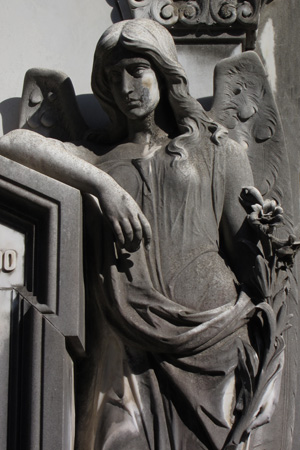
Cornelia passed away without getting married & donated her entire fortune (500,000 pesos or well over USD 1 million in today’s currency) to found an institute for orphan girls over the age of 14. Opened in 1925 & named after her father, children were taught domestic service & girls often sold their textiles to hospitals or to the general public. They even provided employment for women who had grown up in the institute but could not find work. The organization continues to provide service to the city today.
Leave a Comment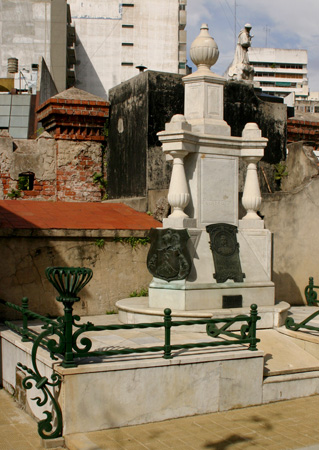
Straddling the east wall & tucked away near a corner, the simple tomb of Brigadier General Juan Martín de Pueyrredón receives few visitors. One of the founding fathers of Argentina, his memorial seems almost low-key compared to some of his contemporaries.
Born in 1777 in Buenos Aires, his father passed away when he was only 14 years old. That event would change his life. Sent at the age of 18 to Cádiz, Pueyrredón took over his father’s export business & continued increasing the family’s fortune. He also took the opportunity to travel in Europe before returning to Argentina in 1805. He’d married his cousin two years earlier, but she passed away (also in 1805) due to complications from a miscarriage. Influential & well-received back home, Pueyrredón first tried to act as a liaison when the British invaded Argentina the following year. But he soon decided to fight & joined local forces that would defeat the British.

Although sent to Spain as a regional representative, Pueyrredón returned just in time to join the 1810 revolution that began his homeland’s struggle for independence. He was not a successful soldier in the following years but was named to replace Juan José Paso in the First Triumvirate —a prototype executive branch in the newly-formed United Provinces of the Río de la Plata. Alongside San Martín, Pueyrredón organized army & naval forces against the Spanish.
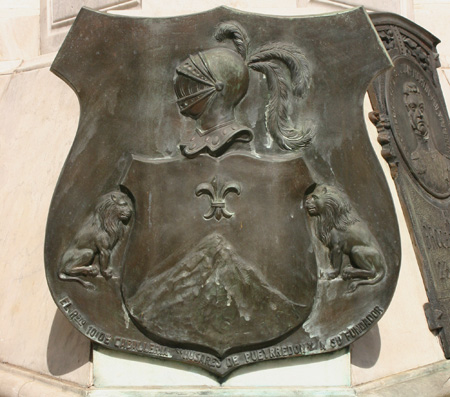
In 1815, Pueyrredón returned to Buenos Aires to marry his second cousin… he was 39 while she was only 14. Times have certainly changed! The following year he was elected as Supreme Director for the national government at a constitutional congress. Pueyrredón founded the national bank & continued to send funds & supplies to San Martín as troops marched toward Perú.
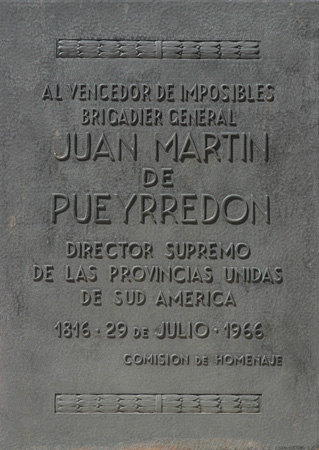
Unfortunately, those early years of independence proved difficult to survive. Discontent brewed within the new government & in 1819, Pueyrredón was forced to resign & eventually went to Montevideo in exile. The political situation changed constantly & he was allowed to return to Buenos Aires two years later. In 1823, his wife gave birth to a boy —Prilidiano— and lived a comfortable life on her family estate in San Isidro. In a brief return to politics, he tried to negotiate an agreement between Juan Manuel de Rosas & Juan Lavalle but to no avail. Leaving for exile in Europe once again, Pueyrredón returned to Buenos Aires in 1849 & passed away a few months later. He left behind a long legacy of public service & commitment to Argentina.
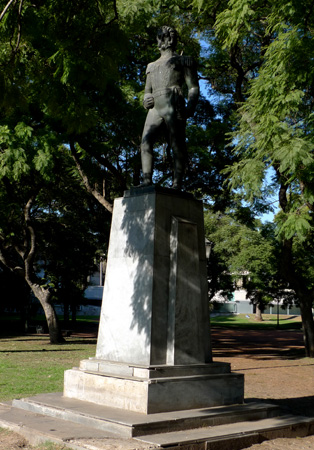
In spite of such a modest tomb, commemoration of Pueyrredón can be found throughout Buenos Aires: his statue decorates Plaza Chile in Palermo (above), a major north-south avenue (ending just behind the cemetery) connects Recoleta with the Once train station, & a small neighborhood in the western part of the city was named after him in 1907.
Leave a CommentBeginning at time marker 12:10 & running until 13:01 –almost a full minute!– is the first video footage from 1949 of Recoleta Cemetery that we’ve seen. (Clicking play above will start the video at the proper moment.) Uploaded to YouTube by the Archivo Historic de Radio y Televisión Argentina, this video highlights the modernity of the Perón era but also fits in a quick look at Recoleta Cemetery.
Tombs & mausoleums are easily identifiable & still exist to this day… although a few have changed their appearance. Occupying the last few seconds of cemetery footage, the Unión Cívica Radical mausoleum had a multitude of plaques covering the entire obelisk:

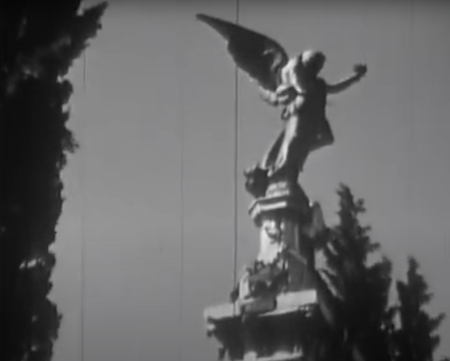
As with the tomb of Sarmiento, plaques became so numerous that they were eventually removed & placed by the underground entrance or on the ground surrounding the obelisk:
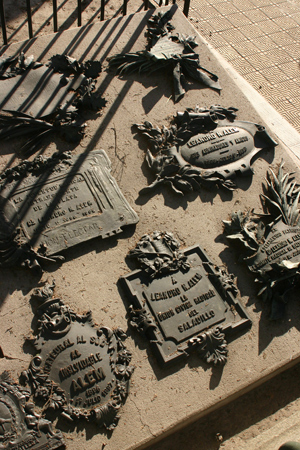
Enjoy this rare glimpse of Recoleta Cemetery with no tourists & without Eva Perón!
Leave a Comment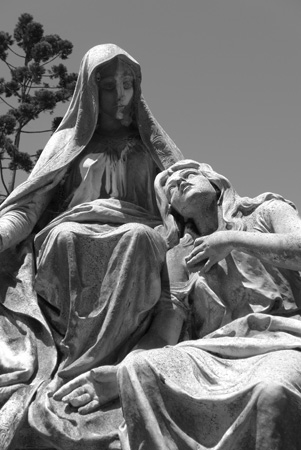
Recoleta Cemetery remains closed to visitors for the time being. But in the spirit of our last post & of armchair travel –all that’s available at the moment– we’d like to share some our other favorite cemeteries from around the world, along with a few suggestions for the future of travel as it relates to cemeteries.
Tourism will change as a result of the pandemic, but that’s good… the industry is long overdue for new paradigms. Crowded museums & big-ticket expositions will likely become a thing of the past. Travellers may search for less-crowded sites to explore & as open-air museums with little public, cemeteries provide a perfect alternative.
One concept that should disappear along with coronavirus is the outdated notion that a kind of world cemetery hierarchy exists. Somewhere, someone invented a statement that Recoleta Cemetery ranks as one of the most important in the world, along with Père Lachaise in Paris & Staglieno in Genoa. On who’s authority? To our chagrin, that tired comparison has been copied & pasted as much as “Buenos Aires is the Paris of South America”:
“la Recoleta es considerado uno de los tres cementerios más importantes del mundo, junto al Pére Lachaise, de París, y el Staglieno, de Génova“
“Renombrado como uno de los cementerios más monumentales del mundo junto con Père Lachaise en las afueras de París y la Colina de Staglieno en Génova“
“Es uno de los más importantes del mundo junto con el de Staglieno en Génova y el Père Lachaise de París“
Basta ya. Each cemetery has something special in its own right. Regular readers of this blog know that Recoleta Cemetery is unique due to its compact nature, its location near the city center, its high concentration of art & architecture & the opportunity to discover almost all of Argentina’s history. The list could go on & on. Recoleta Cemetery needs no comparison… only interest in unlocking its secrets, as with any cemetery around the world. Below are a few of our other favorites:
Milano · Cimitero Monumentale – Not only is the entrance monumental, but fascinating sculpture continues to the very back sections of this grand cemetery. Something breathtaking lies around every corner:
San Sebastián · Cementerio de Polloe – Terraced landscaping takes visitors up & down on the hunt for tombstones written in the Basque language… in spite of being prohibited during the Franco era:
Sydney · Waverley Cemetery – Sure, Rookwood is fantastic; we can all agree with that. But the cliffside location of this cemetery overlooking the water makes for beautiful views throughout:
Washington, DC · Arlington National Cemetery – simple tombstones placed row upon row of those who gave their life for their country, the tomb of the unknown soldier & monuments to both victories & tragedies:
Madrid · Panteón de Hombres Ilustres – Art Nouveau memorials to national greats:
Bucurešti · Bellu Cemetery – Packed tight & full of nature, the rustic layout invites exploration:
Various locations with a single sculpture or a dominant style · Some cemeteries have a monumental piece (or two) that draw pilgrims to see them in person. Others possess a predominant architectural style, & often the stories associated with tombs also attract many visitors:


We hope this brief list of cemeteries other than La Recoleta provides inspiration for future travel. Tombs & mausoleums reflect their time as well as let us know how their occupants wanted to be remembered. Do you have a favorite not listed here? We’ll share more of our travels on request, & we’re always looking for new places to explore. Let us know your best cemetery experience. With a bit of luck, cemetery visits may become part of mainstream tourism soon!
Leave a Comment